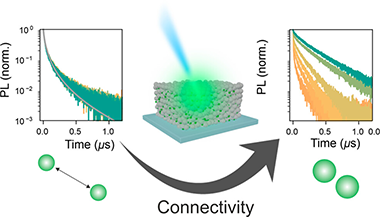Artículos SCI
2008
2008
Materiales Nanoestructurados y Microestructura - Tribología y Protección de Superficies
Microstructural and chemical characterisation techniques for nanostructured and amorphous coatings
Godinho, V; Fernandez-Ramos, C; Martinez-Martinez, D; Garcia-Lopez, J; Sanchez-Lopez, JC; Fernandez, AEuropean Physical Journal-Applied Physics, 43 (2008) 333-341
Show abstract ▽
A full characterization of amorphous or nanostructured coatings at the microstructural level has some intrinsic difficulties associated with the lack of long range order and reference compounds, which often make difficult their study. Only by the combination of different characterization techniques is possible in many cases to achieve valuable chemical and structural information. In this paper, three different systems were used to illustrate how the combination of characterization techniques, as TEM associated to ED or EELS, EFTEM, SEM, XPS, RBS and XRD was determinant to correlate microstructure with deposition parameters and properties in such complex systems. The coatings were deposited on silicon and AISI M2 steel substrates by magnetron sputtering under different Ar/N-2 gas mixtures from Ti and C targets (system 1 and 2) or a Si target (system 3). In each case, the performed characterization allowed to get a deeper understanding of the whole system and explain their mechanical response. The studied systems are: (i) Ti-TiN-CNx multilayered coatings: the chemical and structural analysis shows that a gradual enrichment in nitrogen and nitride phases from the metallic substrate to the CNx top layer is responsible for the improvement of the adhesion properties. (ii) Ti-C-N: the existence of a nanocrystalline TiC phase embedded in an amorphous carbon matrix is demonstrated by the microstructural and chemical analysis for samples prepared under pure Ar. When N-2 is introduced in the gas phase, the nanocrystalline structure is not seen and the chemical composition is enriched in amorphous non-stoichiometric CNx. (iii) SiOxNy: although the coatings present similar composition, small differences in microstructure are observed, which can be responsible for different mechanical properties.
Septiembre, 2008 | DOI: 10.1051/epjap:2008114
Fotocatálisis Heterogénea: Aplicaciones
Degradation of phenylmercury compounds by heterogeneous photocatalysis over alpha-Fe2O3
Navio, JA; Cerrillos, C; Macias, M; Pradera, MAJournal of Advanced Oxidation Technologies, 11 (2008) 411-416
Show abstract ▽
We report here on the degradation of diphenylmercury and monophenylmercury chloride in air-equilibrated aqueous solutions by heterogeneous photocatalysis over alpha-Fe2O3. Photocatalysis proceeded via sequential de-phenylation leaving inorganic mercury. GC-MS analysis of the products revealed that photocatalytic degradation involved hydroxylation of the phenyl rings. Mechanistic features and photocatalytic activity were also studied and are reported upon.
Julio, 2008 | DOI:
2024
2024
Materiales Ópticos Multifuncionales
Effect of Connectivity on the Carrier Transport and Recombination Dynamics of Perovskite Quantum-Dot Networks
Tiede, DO; Romeo-Pérez, C; Koch, KA; Ucer, KB; Calvo, ME; Kandada, ARS; Galisteo-López, JF; Míguez, HACS Nano, 18(6) (2024) 2325-2334
Show abstract ▽

Quantum-dot (QD) solids are being widely exploited as a solution-processable technology to develop photovoltaic, light-emission, and photodetection devices. Charge transport in these materials is the result of a compromise between confinement at the individual QD level and electronic coupling among the different nanocrystals in the ensemble. While this is commonly achieved by ligand engineering in colloidal-based systems, ligand-free QD assemblies have recently emerged as an exciting alternative where nanostructures can be directly grown into porous matrices with optical quality as well as control over their connectivity and, hence, charge transport properties. In this context, we present a complete photophysical study comprising fluence- and temperature-dependent time-resolved spectroscopy to study carrier dynamics in ligand-free QD networks with gradually varying degrees of interconnectivity, which we achieve by changing the average distance between the QDs. Analysis of the photoluminescence and absorption properties of the QD assemblies, involving both static and time-resolved measurements, allows us to identify the weight of the different recombination mechanisms, both radiative and nonradiative, as a function of QD connectivity. We propose a picture where carrier diffusion, which is needed for any optoelectronic application and implies interparticle transport, gives rise to the exposure of carriers to a larger defect landscape than in the case of isolated QDs. The use of a broad range of fluences permits extracting valuable information for applications demanding either low- or high-carrier-injection levels and highlighting the relevance of a judicious design to balance recombination and diffusion.
| DOI: 10.1021/acsnano.3c10239
- ‹ anterior
- 422 of 422














